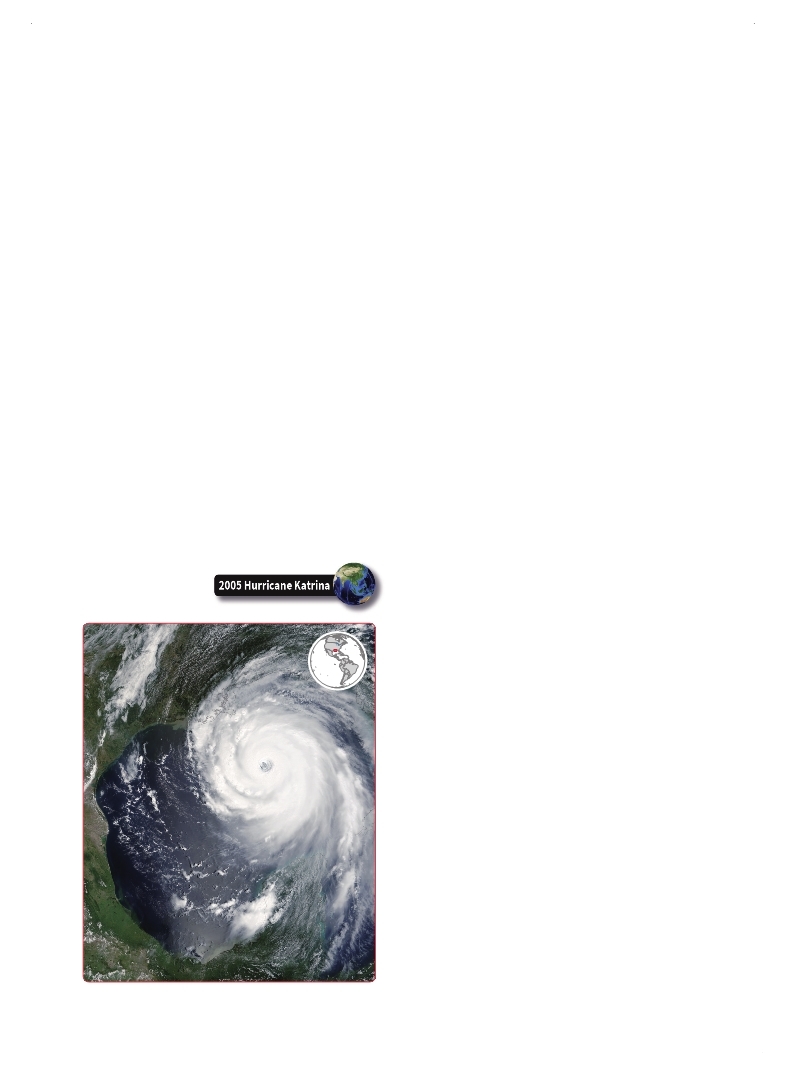 |
Global Assessment Report on Disaster Risk Reduction 2015
Making development sustainable: The future of disaster risk management |
 |
Global Assessment Report on Disaster Risk Reduction 2015
Making development sustainable: The future of disaster risk management |
|
|

24
Chapter 1
(Source: NASA.5)
Figure 1.2
Hurricane Katrina
most coastal populations living there in 2004, the experience of responding to a tsunami had long faded from living memory.
Eight months after the Indian Ocean tsunamis, a very different history of violence unfolded on the other side of the world. On 29 August 2005, Hurricane Katrina (Figure 1.2) hit coastal areas of the States of Louisiana and Mississippi in the United States of America, killing 1,833 people and causing an estimated US$125 billion in economic damage.4
Katrina was a large, strong but not exceptional Category 3 hurricane when it made landfall. In fact, Hurricanes Andrew and Charley, which impacted Florida in 1992 and 2004, respectively, and Hurricane Camille, which hit Mississippi in 1969, involved higher wind speeds and, in the case of the Florida storms, lower central pressure than Katrina (NOAA, 2005
NOAA (National Oceanic and Atmospheric Administration). 2005,Hurricane Katrina, National Climatic Data Center. Updated 29 December 2005.. . considered unexpected. Hurricane early warning systems have existed in the Atlantic Basin since the nineteenth century. Katrina occurred in the middle of the Atlantic hurricane season and made landfall in a region with a history of recurrent hurricane activity.
Similarly, the cascading disaster that unfolded in New Orleans, where the levees that protected the city from flooding were breached and utilities and the transport network collapsed, should not have come as a surprise. Much of the city of New Orleans lay below sea level and was considered a disaster risk hotspot. The Federal Emergency Management Agency (FEMA) had already developed scenarios that modelled the consequences if the levees that protected the city were to fail.
On August 26th, three days before Katrina made landfall, warnings were issued and the Governors of Louisiana and Mississippi declared states of emergency (Moynihan, 2009
Moynihan, Donald P. 2009,The Response to Hurricane Katrina, In International Risk Governance Council report “Risk Governance Deficits: An analysis and illustration of the most common deficits in risk governance”. Geneva.. . Tierney, Kathleen. 2008,Hurricane Katrina: Catastrophic Impacts and Alarming Lessons, Ch. 7. In Risking House and Home: Disasters, Cities, Public Policy, John M. Quigley, and Larry A. Rosenthal, eds. Berkeley, California: Berkeley Public Policy Press. Institute of Governmental Studies Publications.. . When the Mayor of New Orleans finally gave the evacuation order on the morning of August 28th, twenty-four hours before the hurricane made landfall, a significant share of the largely lowincome population that inhabited flood-exposed areas of New Orleans did not have access to any means to evacuate. The contingency plans for the city assumed evacuation by automobile. No plans had been made for those without cars, including the elderly and disabled, or without the resources to procure transport and hotel rooms.
There are many reasons why the federal,state and city authorities, faced with a predictable hazard event and identified risks, failed to respond effectively and why so many people were left behind. FEMA had been weakened as priority shifted from physical hazards like hurricanes to other threats
|
 
Page 1Page 10Page 14Page 15Page 16Page 17Page 18Page 19Page 20Page 21Page 22Page 23Page 24Page 25->Page 26Page 27Page 28Page 29Page 30Page 31Page 32Page 33Page 34Page 35Page 36Page 37Page 38Page 40Page 50Page 60Page 70Page 80Page 90Page 100Page 110Page 120Page 130Page 140Page 150Page 160Page 170Page 180Page 190Page 200Page 210Page 220Page 230Page 240Page 250Page 260Page 270Page 280Page 290Page 300Page 310
|
|
 
|
 
|
